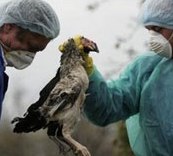Cluster case started from contact with sick chicken

Chickens are dying in unusually large numbers in the same part of Indonesia where as many as seven people were killed by the H5N1 avian influenza virus. Experts now believe that the first victim in this cluster case was probably infected by a diseased bird.
Health experts are still investigating the case, which has drawn strong interest because it is the largest known family cluster involving H5N1. The World Health Organisation (WHO) said this week that limited human-to-human transmission between members of the family might have occurred, although the organisation is not planning to increase the global bird flu alert level.
The United Nations agency currently rates the level of pandemic threat at three on a scale of six, meaning some very limited human-to-human transmission has occurred. Level four would signal evidence of increased human-to-human transmission.
Since re-emerging in Asia in late 2003, the virus has infected at least 218 people worldwide, killing 124 of them. Most of the cases occurred in places with outbreaks of the disease in poultry and victims were infected after direct contact with sick chickens.
Experts are at odds on the issue, with some fearing the virus could spark a global pandemic in which millions could die if it mutates into a form that passes easily from person to person. Others believe that the virus is simply causing a pandemic of fear, saying that significant viral mutations would have to occur before such an outcome would be possible.
Genetic analysis of the strains of the virus found in the cluster case has not indicated that any significant mutations have occurred.













